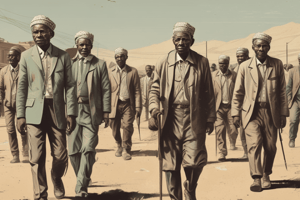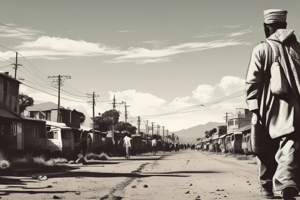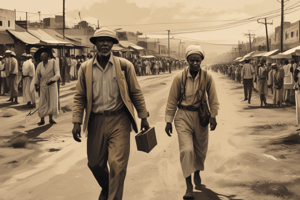Podcast
Questions and Answers
Who became prime minister in 1958 and refined apartheid policy?
Who became prime minister in 1958 and refined apartheid policy?
- Winston Churchill
- Dr. Hendrik Verwoerd (correct)
- F.W. de Klerk
- Nelson Mandela
What was the name given to the 10 homelands created by the Promotion of Bantu Self-Government Act of 1959?
What was the name given to the 10 homelands created by the Promotion of Bantu Self-Government Act of 1959?
- Bantustans (correct)
- Separate Development Areas
- Homelands
- Apartheid Zones
What was the result of the government's policy of forcibly removing black South Africans from rural areas?
What was the result of the government's policy of forcibly removing black South Africans from rural areas?
- They were given jobs in the cities
- They were given land at low prices
- They were deposited in the Bantustans, where they were plunged into poverty and hopelessness (correct)
- They were given full political rights
How many people were forcibly removed from their homes and deposited in the Bantustans between 1961 and 1994?
How many people were forcibly removed from their homes and deposited in the Bantustans between 1961 and 1994?
What was the supposed benefit of the Bantustans system for black South Africans?
What was the supposed benefit of the Bantustans system for black South Africans?
What was the result of the government selling land at low prices to white farmers?
What was the result of the government selling land at low prices to white farmers?
What year did the UN Security Council vote to impose a mandatory embargo on the sale of arms to South Africa?
What year did the UN Security Council vote to impose a mandatory embargo on the sale of arms to South Africa?
What was the outcome of the 1994 elections in South Africa?
What was the outcome of the 1994 elections in South Africa?
What significant change occurred in South African law in 1994?
What significant change occurred in South African law in 1994?
What prompted Pieter Botha's government to institute some reforms in the 1980s?
What prompted Pieter Botha's government to institute some reforms in the 1980s?
What was the result of F.W. de Klerk's government's reforms?
What was the result of F.W. de Klerk's government's reforms?
What was the main goal of the Freedom Charter adopted in 1955?
What was the main goal of the Freedom Charter adopted in 1955?
What event in 1960 led to the deaths of at least 67 black people and the wounding of over 180?
What event in 1960 led to the deaths of at least 67 black people and the wounding of over 180?
What was the name of the military wing of the ANC established in 1961?
What was the name of the military wing of the ANC established in 1961?
Who was the founder of Umkhonto we Sizwe and was imprisoned from 1963 to 1990?
Who was the founder of Umkhonto we Sizwe and was imprisoned from 1963 to 1990?
What was the reason behind the 1976 protests in Soweto?
What was the reason behind the 1976 protests in Soweto?
What was the result of the government's crackdown on the 1976 protests in Soweto?
What was the result of the government's crackdown on the 1976 protests in Soweto?
What was the outcome of the Sharpesville massacre on the anti-apartheid movement?
What was the outcome of the Sharpesville massacre on the anti-apartheid movement?
What was the result of the combination of the protests and government crackdowns in 1976 and the national economic recession?
What was the result of the combination of the protests and government crackdowns in 1976 and the national economic recession?
Flashcards are hidden until you start studying
Study Notes
Apartheid Policy under Dr. Hendrik Verwoerd
- Dr. Hendrik Verwoerd became prime minister in 1958 and refined apartheid policy into "separate development".
- The Promotion of Bantu Self-Government Act of 1959 created 10 Bantu homelands known as Bantustans.
- The Bantustans separated black South Africans from each other, allowing the government to claim there was no black majority and reducing the possibility of black nationalism.
- Every black South African was designated as a citizen of one of the Bantustans, supposedly giving them full political rights, but effectively removing them from the nation's political body.
Forced Removals and Land Dispossession
- The government forcibly removed black South Africans from rural areas designated as "white" to the Bantustans.
- The government sold their land at low prices to white farmers.
- Between 1961 and 1994, more than 3.5 million people were forcibly removed from their homes and deposited in the Bantustans.
- The forced removals led to widespread poverty and hopelessness in the Bantustans.
Forms of Resistance
- Non-violent demonstrations, protests, and strikes were forms of resistance to apartheid within South Africa.
- Political action and armed resistance were also used to fight against apartheid.
Early Resistance Efforts
- In 1952, the ANC and South Indian National Congress organized a mass meeting where attendees burned their pass books.
- The Freedom Charter was adopted in 1955, asserting that "South Africa belongs to all who live in it, black or white."
- The government broke up the meeting and arrested 150 people, charging them with high treason.
Sharpesville Massacre
- In 1960, the police opened fire on a group of unarmed blacks associated with the Pan-African Congress (PAC) at Sharpesville, killing at least 67 and wounding over 180.
- The event convinced many anti-apartheid leaders that peaceful means would not achieve their objectives.
Military Wings and Leadership
- The PAC and ANC established military wings, but neither posed a serious military threat to the state.
- By 1961, most resistance leaders had been captured and sentenced to long prison terms or executed.
- Nelson Mandela, a founder of Umkhonto we Sizwe, was incarcerated from 1963 to 1990, drawing international attention and support for the anti-apartheid cause.
Soweto Uprising
- In 1976, thousands of black children in Soweto demonstrated against the Afrikaans language requirement, leading to police crackdowns and international attention.
- The protests and government crackdowns shattered illusions that apartheid had brought peace or prosperity to the nation.
International Pressure
- The United Nations General Assembly denounced apartheid in 1973.
- The UN Security Council voted to impose a mandatory embargo on the sale of arms to South Africa in 1976.
- The United Kingdom and United States imposed economic sanctions on the country in 1985.
Reforms and End of Apartheid
- In 1985, the National Party government of Pieter Botha sought to institute reforms, including the abolition of pass laws and the ban on interracial sex and marriage.
- By 1989, Botha was pressured to step aside in favor of F.W. de Klerk.
- De Klerk's government repealed the Population Registration Act and most of the other legislation that formed the legal basis for apartheid.
- A new constitution, which enfranchised blacks and other racial groups, took effect in 1994, and elections that year led to a coalition government with a nonwhite majority, marking the official end of the apartheid system.
Studying That Suits You
Use AI to generate personalized quizzes and flashcards to suit your learning preferences.




